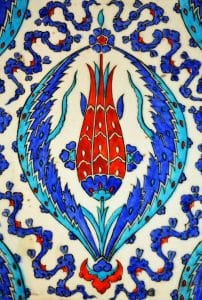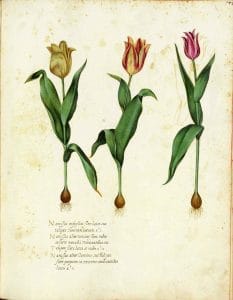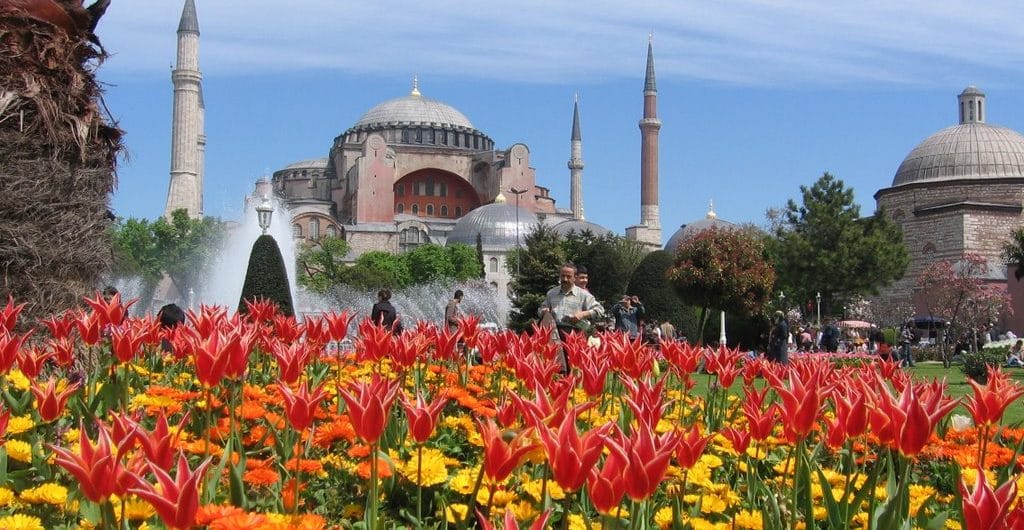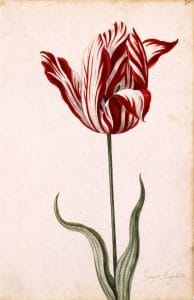The Tulip
The Tulip was originally a wild flower growing in Central Anatolia. Although most people believe that the Dutch first cultivated the Tulip. The plants were originally harvested, and subsequently, cultivated by the Turks as early as 1,000 AD. The Turkish word for Tulip ‘lale’ gave its name to the richest period of the mighty Ottoman Empire. The Lale Devri, literally the Tulip Era.
Tulips were first introduced to Western Europe and the Netherlands in the 17th century by Carolus Clusius, a biologist born in the Flemish region of northern France. In 1587 the University of Leiden asked for permission from the mayor of Leiden to establish a horticultural academy, for the benefit of the medical students. The request was granted in 1590, and the now famous botanist Carolus Clusius was appointed as prefect. His knowledge, reputation, and international contacts allowed him to set up a very extensive plant collection. The original garden set up by Clusius was small (about 35 by 40 meters), but contained more than 1000 different plants. Clusius was gifted some bulbs from Turkey from his friend, the ambassador of Constantinople. He had seen the beautiful flower growing in the palace gardens and sent a few to Clusius for his garden in Leiden. Clusius planted them and this was the start of the amazing varieties that we see today.
The Netherlands
In the beginning of the 17th century the tulip was starting to be used as a garden plant as well as for medicinal purposes. Tulip flowers are known to be an excellent poultice for insect bites, bee stings, burns, and rashes on the skin. The Tulip soon gained popularity among the elite of the Netherlands, as the country entered its Golden Age its wealthy patrons were experiencing an increase in the economy.

Interest in the flower and the different colours grew rapidly and the bulbs began to be sold for unbelievably high prices. Botanists started to hybridize the flower and they soon found ways of making the petals even more decorative. Hybrids and mutations of the flower were seen as rarities and a sign of high status. In the months of late 1636 to early 1637 the now infamous “Tulipmania” occurred in the Netherlands. Some examples of the bulbs could cost more than a house. Even the ordinary man took part in the madness. They saw how much money the upper class were making and thought that this was an easy way to cash in with very little risk. The bulbs was usually sold by weight while they were still in the ground. This trade with the un-sprouted flower became known as a “wind trade”. The very nature of the Tulip helped to fuel the desire. The fact that all bulbs take years to produce flowers and the original bulb only last 3 to 4 years, coupled with the fact that hybridized plants are nearly always sterile meant that the flowers appeared rare and exotic.
Today we know that the frilly petals and dramatic stripes that gave the flower its stunning look, in fact were the symptoms of an infection caused by the mosaic virus. The healthy natural flowers are singularly coloured with smooth waxy petals. The virus came to the tulip from an aphid living on peaches and potatoes. These diseased varieties are no longer sold, but you can find hybrids that look similar but are genetically stable.
 Tulip Mania
Tulip Mania
The traders made huge amounts of money every month, and people sold everything they owned to be able to cash in. Houses, livestock, businesses were all gambled on the humble bulb. The contract price of rare virused bulbs continued to rise throughout 1636, but by November, the price of common, single colour bulbs also began to increase. Eventually any tulip bulb could fetch hundreds of guilders. The trade was built on supply and demand but finally the tulip bulbs had saturated the market. They were no longer quite so rare and were no longer able to justify such high prices. As usually happens over supply led to lower prices and dealers went bankrupt. Many traders lost their life savings because of the trade. This “Tulip Crash” made the government introduce special trading restrictions for the flower. It is said that the flower became so popular because of the bright colours, dramatic flames and frilly petals. To have tulips in one’s home was a way to impress, and when the wealth spread down the social ladder, so did the urge for tulips.
Today Tulips are still hugely popular. The fields of the Netherlands are a riot of colour in the spring and every year since 2006, the workers of Istanbul plant millions of Tulip bulbs. In parks, avenues, traffic roundabouts and anywhere there is open ground.
In 2016, over 30 million bulbs were planted for the annual Tulip Festival. The plants begin to bloom in March and continue for approximately a month. There are lots more little known facts about Turkey we would like to share with you, head over to our Practical Information section within the Dalyan Guide to find out!


 Tulip Mania
Tulip Mania
Comments